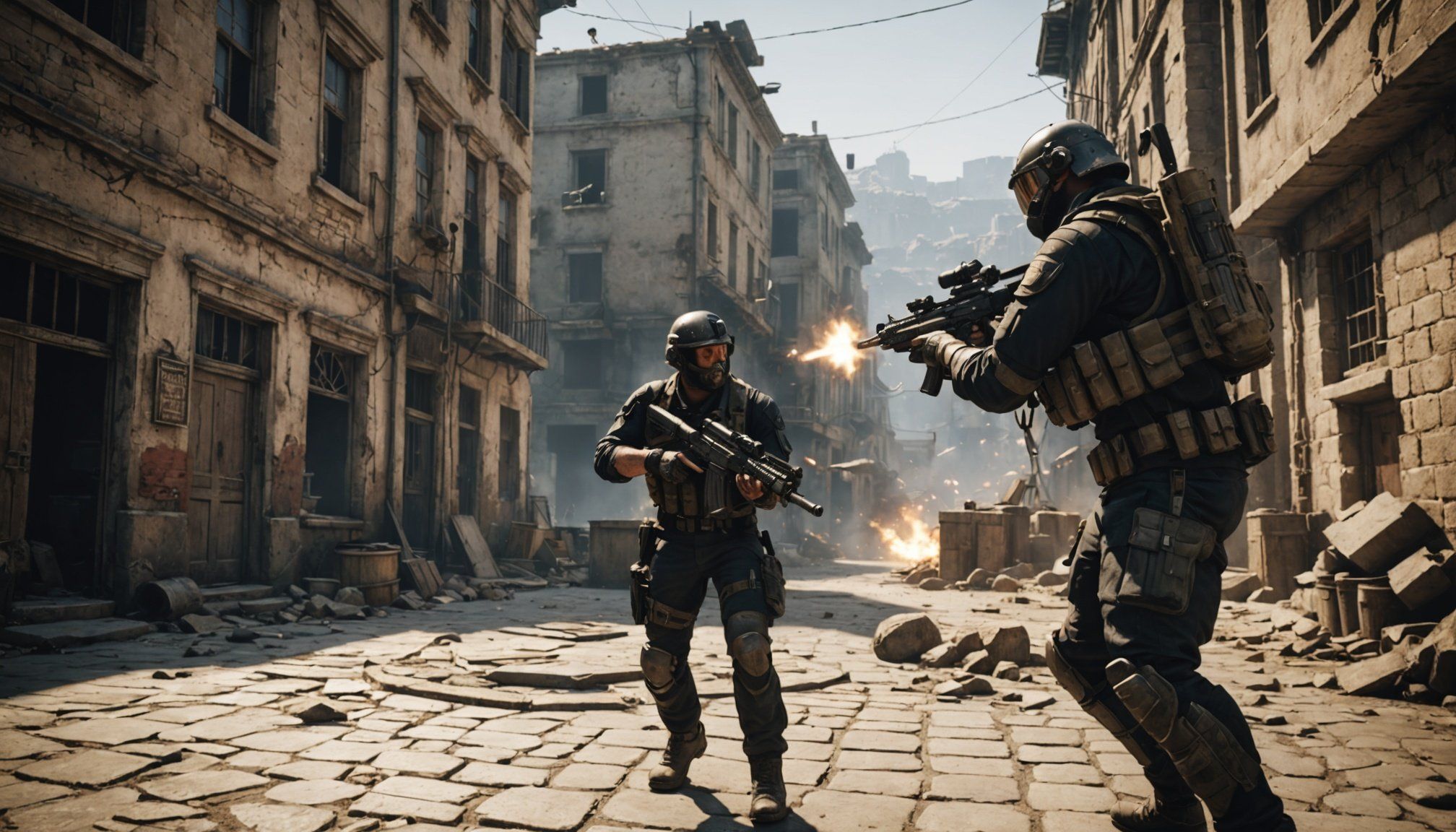Revolutionizing Action Gaming: The Impact of Real-Time Physics on Combat Realism
The Evolution of Physics in Gaming
The gaming industry has undergone a significant transformation over the years, and one of the most impactful advancements has been the integration of real-time physics into game design. This shift has particularly revolutionized action gaming, enhancing the realism and immersion of combat experiences.
In the early days of gaming, physics were often simplistic and did not reflect real-world interactions. However, with the advancement of technology and the development of sophisticated physics engines, games can now simulate complex physical interactions with remarkable accuracy. For instance, games like Half-Life: Alyx have set a new benchmark for VR physics, offering players an incredibly immersive experience through carefully constructed interactions and environments[1].
Also to see : Unleashing AI Creativity: Crafting Unique Roguelike Game Levels with Procedural Innovations
Enhancing Realism and Immersion
Real-time physics simulations play a crucial role in creating a more realistic and engaging gaming experience. Here are a few ways in which physics enhance combat realism:
Dynamic Interactions
Games like Blade and Sorcery and Hard Bullet exemplify how dynamic physics interactions can elevate the gaming experience. In Blade and Sorcery, players can engage in realistic melee combat where blades can get lodged into opponents, and weapons behave as expected in the real world. This level of detail makes the game feel incredibly immersive and realistic[1].
Topic to read : Next-Gen Wildlife Simulations: Unlocking Immersive Gaming Experiences with Real-Time Biome Data
Realistic Environments
The inclusion of real-time physics also extends to the environment. In Half-Life: Alyx, players can interact with objects in a way that feels natural and realistic. For example, writing on glass with a marker pen or manipulating objects in the environment creates a compelling and immersive feel[1].
Player Actions and Feedback
Real-time physics provide immediate and tactile feedback to player actions. For instance, in Eleven Table Tennis, the physics system simulates the real sport with impressive accuracy, allowing players to experience the game as if they were playing in real life. This immediate feedback enhances the gaming experience, making it more engaging and realistic[1].
Key Features of Real-Time Physics Engines
Modern physics engines, such as the Phaser Box2D, offer several key features that contribute to the realism and stability of physics simulations in games.
Continuous Collision Detection
The Continuous Collision Detection (CCD) system in Phaser Box2D handles high-velocity scenarios with precision, ensuring that fast projectiles and rapid character movements are accurately tracked. This prevents missed interactions and tunneling, which can disrupt the realism of the game[3].
Soft Step Rigid Body Solver
The Soft Step solver in Box2D v3.0 provides greater stability across various scenarios, managing higher mass ratios, longer body chains, and larger stacks effectively. This ensures accurate and stable simulations even in complex environments[3].
Island-Based Sleep Management
This feature boosts performance by pausing calculations for objects at rest, freeing up processing power for active elements. This is particularly useful in games with dense environments, where resources need to be allocated efficiently[3].
Impact on Game Development
The integration of real-time physics has significant implications for game development.
Increased Complexity and Realism
Developers can create more complex and realistic game environments. For example, in Hard Bullet, the game’s physics engine allows for a sandbox experience where players can interact with enemy AI and objects in a highly dynamic and realistic manner[1].
Enhanced Player Engagement
Real-time physics enhance player engagement by providing a more immersive and interactive experience. Players can learn and adapt to the game’s physics, which adds a layer of depth to the gameplay. In Blade and Sorcery, the realistic physics of melee combat encourage players to experiment with different strategies and techniques[1].
Challenges and Considerations
While real-time physics offer numerous benefits, they also present challenges. Developers must balance realism with performance, ensuring that the game runs smoothly without compromising on the physics simulations. Here are some considerations:
- Performance Optimization: Ensuring that the physics engine does not overload the system, especially in games with complex environments.
- Realism vs. Fun: Balancing realism with the need for an enjoyable gaming experience. Games like Hard Bullet prioritize fun and dynamic physics over strict realism[1].
- Player Learning Curve: Introducing players to the game’s physics in a way that is intuitive and easy to learn, without overwhelming them with complexity.
Practical Insights and Actionable Advice
For game developers looking to integrate real-time physics into their games, here are some practical insights and actionable advice:
Start with Simple Interactions
Begin by implementing simple physics interactions and gradually build complexity. This helps in testing and refining the physics engine without overwhelming the system.
Use Advanced Physics Engines
Utilize advanced physics engines like Phaser Box2D, which offer robust features such as Continuous Collision Detection and Soft Step rigid body solvers. These engines can handle complex scenarios with precision and stability[3].
Test and Iterate
Thoroughly test the physics interactions and iterate based on feedback. This ensures that the game feels realistic and responsive to player actions.
Balance Realism and Performance
Balance the level of realism with the need for smooth performance. Optimize the physics engine to ensure that the game runs efficiently without compromising on the realism of the interactions.
Examples of Games That Excel in Real-Time Physics
Here are some examples of games that have successfully integrated real-time physics to enhance their combat realism:
| Game | Platform | Developer | Key Physics Features |
|---|---|---|---|
| Half-Life: Alyx | PC, VR | Valve | Realistic object interactions, detailed environment physics[1] |
| Blade and Sorcery | Meta Quest, PC | Warpfrog | Realistic melee combat, dynamic physics interactions[1] |
| Hard Bullet | PC | GexagonVR | Dynamic physics, ragdoll system, full collision for objects[1] |
| Eleven Table Tennis | Oculus/Meta Quest, PICOXR, PC | Roman Rekhler, Hamzeh Alsalhi, Oscar Vazquez | Realistic table tennis simulation, accurate ball and bat interactions[1] |
Quotes from Industry Experts
- “The key to creating an immersive gaming experience is to make the physics feel natural and responsive. Players should feel like they are interacting with a real world, not just a virtual one.” – David Speyrer, Game Developer at Valve
- “Real-time physics are not just about making the game look realistic; they are about creating a deep and engaging gameplay experience. When players can interact with the environment in a meaningful way, it adds a whole new level of depth to the game.” – Roman Rekhler, Developer of Eleven Table Tennis
The Future of Real-Time Physics in Gaming
As technology continues to advance, we can expect even more sophisticated physics simulations in games. Here are a few trends that are likely to shape the future of real-time physics in gaming:
Integration with Machine Learning and AI
The use of machine learning and artificial intelligence (AI) can further enhance physics simulations. For example, AI can be used to predict player actions and adjust the physics accordingly, creating a more dynamic and responsive experience.
Advanced Visual Effects
Improved visual effects, such as more realistic lighting and textures, will complement the real-time physics, making the game world feel even more immersive and realistic.
Cross-Platform Compatibility
As physics engines become more robust, we can expect to see more cross-platform compatibility, allowing players to experience the same level of physics realism across different devices.
Real-time physics have revolutionized the gaming industry, particularly in the realm of action gaming. By providing realistic and immersive interactions, these simulations enhance the overall gaming experience, making games feel more engaging and realistic. As technology continues to evolve, we can expect even more sophisticated and realistic physics simulations, further blurring the line between the virtual and real worlds.
In the words of a game developer, “The future of gaming is not just about better graphics or more complex storylines; it’s about creating a world that feels real and interactive. Real-time physics are at the heart of this vision, and they will continue to shape the gaming industry in profound ways.”
Technical Challenges and Solutions
Implementing real-time physics in game development presents an array of technical challenges that developers must expertly navigate to create seamless and immersive experiences. One primary hurdle is achieving the balance between game mechanics and real-time processing power. Games must run smoothly without compromising the physics simulations that drive combat mechanics and environments.
To overcome these challenges, developers often optimise physics engines to suit the specific needs of their game. Innovations such as adaptive algorithms have been pivotal in reducing computational load, allowing for real-time adjustments that maintain performance standards across different gaming platforms.
Another significant challenge lies in accurately simulating complex interactions. For example, ensuring that objects in a game behave as expected when subjected to various forces requires precise calculations. Here, the use of machine learning in refining physics engines shows promise, offering more sophisticated prediction and adaptation capabilities.
Developers also emphasise user feedback within the game development process. This feedback guides improvements and helps address challenges related to interactivity and player experience.
These insights not only tackle current technical constraints but also pave the way for future enhancements in the ever-evolving landscape of action gaming.











